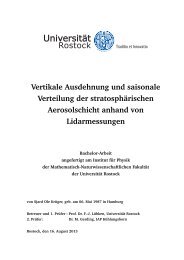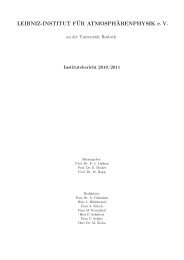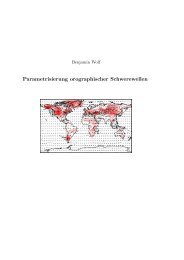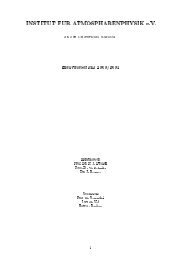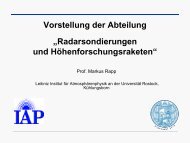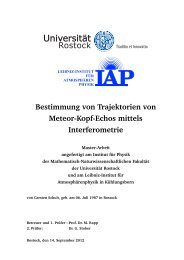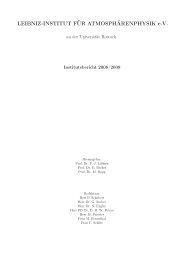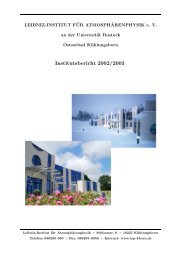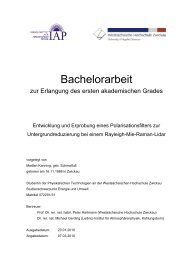Polar mesosphere summer echoes (PMSE): review of ... - HAL
Polar mesosphere summer echoes (PMSE): review of ... - HAL
Polar mesosphere summer echoes (PMSE): review of ... - HAL
You also want an ePaper? Increase the reach of your titles
YUMPU automatically turns print PDFs into web optimized ePapers that Google loves.
M. Rapp and F. J. Lübken: Review <strong>of</strong> <strong>PMSE</strong> 2609<br />
Fig. 10. Occurrence rates <strong>of</strong> <strong>PMSE</strong> (solid line) and neutral air turbulence<br />
(histogram and dashed line) according to Rapp and Lübken<br />
(2003a).<br />
Fig. 9. Comparison <strong>of</strong> turbulent energy dissipation rates ɛ (color<br />
coded) and the <strong>PMSE</strong> intensity for 8 sounding rocket flights. This<br />
figure is reproduced from Lübken et al. (2002), copyright by the<br />
American Geophysical Union.<br />
during the NLC91 campaign, 2 during the SCALE campaign,<br />
3 during the ECHO campaign, 1 during the DROPPS<br />
campaign, 2 during the SOLSTICE campaign and 3 during<br />
the MIDAS/MACWAVE campaign; see Table 2). The results<br />
from the first 8 launches were summarized by Lübken<br />
et al. (2002). The turbulence measurements during the SOL-<br />
STICE campaign are reported in Müllemann et al. (2003)<br />
and results from the three sounding rocket flights during the<br />
MIDAS/MACWAVE campaign have just recently been published<br />
in Strelnikov et al. (2003) and Rapp et al. (2004), respectively.<br />
Individual comparisons <strong>of</strong> <strong>PMSE</strong> observations<br />
and turbulence measurements are shown in Fig. 9. It is evident<br />
from this figure that there is clearly no one to one correlation<br />
between the occurrence <strong>of</strong> turbulence and the occurrence<br />
<strong>of</strong> <strong>PMSE</strong>. Lübken et al. (2002) performed a statistical<br />
analysis <strong>of</strong> these data and found that in more than 50% <strong>of</strong> all<br />
altitude bins where <strong>PMSE</strong> was observed there was no neutral<br />
air turbulence present. If, however, turbulence and <strong>PMSE</strong><br />
occurred at the same altitudes it regularly only happened in<br />
the upper portion <strong>of</strong> the <strong>PMSE</strong> layer (i.e., in flight NBT05,<br />
SCT06, ECT02, ECT07, MDMI05; it is worth noting here<br />
that this is also consistent with radar observations showing<br />
enhanced spectral widths predominantly in the upper altitude<br />
range <strong>of</strong> the <strong>PMSE</strong> layers; see for example Czechowsky<br />
et al.,1988). In addition, it must be noted that turbulence was<br />
<strong>of</strong>ten observed at altitudes where no <strong>PMSE</strong> was present, i.e.,<br />
normally above the <strong>PMSE</strong> layer and in two cases (NBT05,<br />
ECT12) also below the <strong>PMSE</strong> layer. The more recent observations<br />
by Müllemann et al. (2003), Strelnikov et al. (2003),<br />
and Rapp et al. (2004) confirm this general picture <strong>of</strong> the<br />
morphology <strong>of</strong> turbulence and <strong>PMSE</strong>.<br />
To summarize, in Fig. 10 we compare the occurrence rate<br />
<strong>of</strong> <strong>PMSE</strong> with the occurrence rate <strong>of</strong> neutral air turbulence<br />
as determined from the sounding rocket flights mentioned<br />
above (see Rapp and Lübken, 2003a, for details how these<br />
occurrence rates were determined). Figure 10 shows that in<br />
a climatological sense neutral air turbulence indeed occurs in<br />
the entire altitude range where <strong>PMSE</strong> is observed. At altitudes<br />
above ∼86 km the turbulence occurrence rate is even<br />
larger than the <strong>PMSE</strong> occurrence rate. At lower altitudes,<br />
however, the <strong>PMSE</strong> occurrence rate is significantly larger<br />
than the turbulence occurrence rate, for example at 85 km<br />
<strong>PMSE</strong> occur with a rate <strong>of</strong> ∼65% whereas turbulence only<br />
occurs with a rate <strong>of</strong> ∼35%. Hence, at the lower altitudes in<br />
the <strong>PMSE</strong> altitude range, neutral air turbulence can clearly<br />
not directly account for the occurrence <strong>of</strong> <strong>PMSE</strong>.<br />
2.4.3 Electron biteouts and small scale plasma structures<br />
One <strong>of</strong> the most prominent features <strong>of</strong> the <strong>PMSE</strong> environment<br />
is the fact that the electron number density appears to be<br />
frequently disturbed in the altitude region <strong>of</strong> the radar <strong>echoes</strong>.<br />
Figure 11 shows one <strong>of</strong> the earliest observations from the<br />
www.atmos-chem-phys.org/acp/4/2601/ Atmos. Chem. Phys., 4, 2601–2633, 2004



